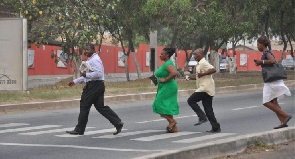Walking, aside being the oldest mode of transport, improves health, and one of the most exciting ways of exercising, there are certain parts of our cities where there is no better way to orientate oneself than on foot. But you know how it feels when you try so hard to cross a road and a driver comes through the intersection as if you are not even there.
Well, enough of the perception that ''our streets belong to the car.'' The car do not own a street, all the streets belong to the kings and queens—the pedestrians. Let me put it down before my pen stops to write that everyone is a pedestrian. Oh yes! We are all pedestrians because at any point in time we can choose to walk to and from our various destinations. Reclaiming and protecting the much assaulted right-of-way of the pedestrian on our roads, therefore, remains one of our civic responsibilities. It is our duty to make Ghana a walkable country, and this duty cannot be barter traded for excuses.
In a heavy pedestrianized country like Ghana, the pedestrian should have been the first to come to mind when designing our roads; remorsefully, right from the get-go, our roads were constructed without considering the pedestrian, and unfortunately, the needs of pedestrians are still overlooked in our transportation planning. Finding the culprits behind the status quo of our roads is not what this discourse desires; the effort in here is aimed at calling for the strengthening of safety measures on our streets so that the lives of pedestrians can be respected and protected.
It is sad and interesting how pedestrians kneel before drivers in order to gain permission to cross a road. This makes the argument that crossing most roads in this country is a life and death matter tenable. But as we covet to making Ghana or Accra a modern city, it cannot escape our minds that one of the colourful features of a modern is that, the disabled are able to make their way to and from their destination without a helping hand. This comes as no surprise because in such cities the pedestrian: abled and disabled are thought about during transportation planning.
Reports from the Motor Traffic and Transport Department of the Ghana police service (MTTD) and National Road Safety Commission (NRSC) admit that out of 3,300 recorded knockdowns nationwide last year (2017), 2,076 people lost their lives. Another rueful report from data analysis released by the Charted Institute of Logistics and Transport (CILT) Ghana, confesses that 879 vehicular knockdowns were recorded on our highways in 2017.
In an attempt to run away way from the collective responsibility, it will be easy for vehicle owners and some authorities mandated to ensure the safety of pedestrians, to point at pedestrian negligence — amongst other factors like insufficient pedestrian facilities, drivers exceeding speed limits, drink driving, and so on — as the prime cause of the aforementioned knockdowns and death toll. Nonetheless, this reason will be poorly received because pedestrian crossings on our streets like zebra crossings and pelicans are countable in this country. Puffins and toucans which serve as the safest crossing points are missing on our roads. Underground crossings are still alien to this country, and sidewalks which do not only serve as safer routes for pedestrians, but also augment the aesthetic view of our cities are yet to win the love of authorities and stakeholders.
Pretending to have enough overheads crossing on our highways can be the cheapest task ever, but escaping from the consequences of our pretense will be a daunting task for us to overcome. This is evident in the number of deaths recorded on the N1 highway in Accra and the Tema motorway yearly. The 299 deaths of pedestrians recorded on the N1 highway and Tema motorway collectively, as contained in the CILT report, could have been averted if we had situated — at appropriate points and not just anywhere — the requisite number of overheads crossing on the Motorway and the N1 highway.
Driving faster than authorized speed limit, accelerating to avoid waiting at traffic light, should be of concern to us. Controlling drink driving and driving under the influence of drugs, separating pedestrians from other traffic by sidewalks and crosswalks, improving the safety routes to and from schools and in school zones, increasing visibility of the pedestrian and ensuring the responsible behavior of all road users are the measures that can adequately address the range of risk of pedestrians across various settings.
Pedestrian understands that, generally, he/she has the right-of-way in a crosswalk and on a sidewalk. He/she understands that he/she is to walk on the sidewalk and not on the roadway. Again, the king understands very well that he is not supposed to step in the crosswalk or leave the sidewalk when it is impossible for a motor vehicle driver to yield to him. But, just as it is important that the pedestrian is enlightened that he/she is prohibited from standing in a roadway in order to obtain a ride or to solicit business from a motor vehicle driver, it is also imperative that the driver learn to yield to pedestrian on crosswalk and sidewalk.
It is a great idea that we all assume responsibility for our safety and the safety of others when sharing road space as it remains ideal that we remember that pedestrians — the supposed kings and queens of the streets — are the most vulnerable of all road users and deserve our protection.
By: Rahim Newton
abdulrahimnewton@yahoo.com
- Construction works on Tepa-Goaso road to commence April ending - Roads Minister
- Obetsebi Lamptey interchange project to be completed by September – Roads Minister
- Pay contractors - Ghana Chamber of Construction Industry appeals to government
- Potholes on Amasaman, Nsawam roads can be used as graves - Chief
- Road users must be disciplined – Eastern Regional Minister urges
- Read all related articles













